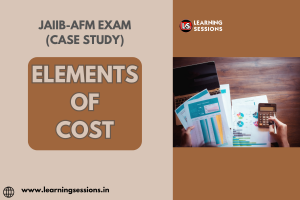The JAIIB Accounting and Financial Management (AFM) module covers several key financial concepts, including the elements of cost, which are fundamental to effective cost management and decision-making. Mastering these elements helps financial professionals in banking and other sectors manage operational costs, maximize profitability, and maintain competitive pricing strategies. Learning Sessions brings this article, in which we will explore the elements of cost with a focus on their significance in the banking sector, supported by a case study that illustrates how banks utilize cost elements in their financial operations.

📚 JAIIB Study Resources 📚
👉 Check Here
👉 Check Here
👉 Check Here
👉 Get Tests Here
👉 Check Here
DOWNLOAD PDF ELEMENTS OF COST -CASE STUDY
In financial management, the elements of cost are the components that contribute to the total cost of producing a product or delivering a service.
For the extensive preparation of candidates, get details through our YouTube videos for JAIIB AFM Module wise Syllabus with explanations and tips to help candidates in their preparation journey.
You may also like these JAIIB case studies:
JAIIB | AFM | SUBSIDIARY BOOKS
JAIIB | AFM | OVERDRAFT BALANCE
These costs are typically classified into three main categories:
- Material Costs
- Labor Costs
- Expenses/Overheads
By breaking down costs into these elements, banks and other financial institutions can identify areas where they can reduce expenses, improve efficiency, and maintain profitability.
Additionally Direct Costs, Indirect Costs, Fixed Costs, Variable Costs and Semi-Variable Costs are few Key Elements of Cost in Banking
Moving further, talking about the Importance of Understanding Elements of Cost in Banking, these are following aspects:
- Cost Control and Reduction
- Pricing Strategies
- Profitability Management
- Decision-Making
Considering all this, the elements of cost are an essential part of the JAIIB AFM module, equipping banking professionals with the knowledge to manage financial resources effectively. By breaking down costs into direct, indirect, fixed, variable, and semi-variable categories, banks can streamline their operations, enhance profitability, and make informed decisions. The case study illustrates how a clear understanding of these cost elements can lead to better financial performance, improved cost control, and a sustainable business model. Learning Sessions provides additional information about JAIIB AFM TRANSFER PRICING by giving examples of real life scenarios.
Learn more about this case study through our YouTube channel and PDF.
Get access to our Telegram Channel for free Pdfs of JAIIB.







